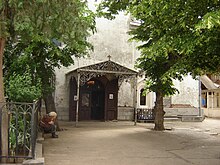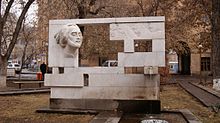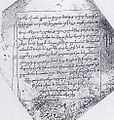| Revision as of 22:56, 17 June 2018 edit2601:47:4100:a7b:2962:19f1:4fdc:2036 (talk)No edit summary← Previous edit | Revision as of 22:57, 17 June 2018 edit undo2601:47:4100:a7b:2962:19f1:4fdc:2036 (talk)No edit summaryNext edit → | ||
| Line 56: | Line 56: | ||
| <gallery> | <gallery> | ||
| File:Sayat-Nova manuscript 01.JPG|An Armenian poem written by Sayat-Nova using mix of Armenian and Georgian alphabets. | File:Sayat-Nova manuscript 01.JPG|An Armenian poem written by Sayat-Nova using mix of Armenian and Georgian alphabets. | ||
| File:Sayat-Nova manuscript 02.JPG|A poem written in Azeri Turkish using Georgian letters. | |||
| </gallery> | </gallery> | ||
Revision as of 22:57, 17 June 2018
For the Armenian town, see Sayat-Nova, Armenia. For 1968 film known as Sayat Nova, see The Color of Pomegranates.
| Sayat-Nova | |
|---|---|
 Soviet stamp from 1962 devoted to Sayat-Nova's 250 anniversary. Soviet stamp from 1962 devoted to Sayat-Nova's 250 anniversary. | |
| Born | Harutyun Sayatyan (1712-06-14)14 June 1712 Tiflis, Kingdom of Kartli, Safavid dynasty (present-day Georgia) |
| Died | 22 November 1795(1795-11-22) (aged 83) Haghpat, Kingdom of Kartli-Kakheti, Qajar dynasty (present-day Armenia) |
| Occupation | Poet, ashugh |
| Nationality | Armenian |
| Spouse | Marmar |

Sayat-Nova (Template:Lang-hy; Azerbaijani: Səyyad Nova; Persian: سایاتنوفا; Georgian: საიათნოვა; born Harutyun Sayatyan; 1712/1722 – 22 September 1795) was a Georgian born Armenian poet, musician and ashugh, who had compositions in a number of languages. His songs are in Armenian, Georgian, and Persian.
The name Sayat-Nova means "King of Songs" in Persian.
Biography
| This section needs additional citations for verification. Please help improve this article by adding citations to reliable sources in this section. Unsourced material may be challenged and removed. (April 2013) (Learn how and when to remove this message) |
Sayat-Nova's mother, Sara, was born in Tiflis, and his father, Karapet, either in Aleppo or Adana. He was born in Tiflis. Sayat Nova was skilled in writing poetry, singing, and playing the kamancheh, Chonguri, Tambur. He performed in the court of King Heraclius II of Georgia, where he also worked as a diplomat and, apparently, helped forge an alliance between Georgia, Armenia and Shirvan against the Persian Empire. He lost his position at the royal court when he fell in love with the king's sister Ana; he spent the rest of his life as an itinerant bard.
In 1759 he was ordained as a priest in the Armenian Apostolic Church. His wife Marmar died in 1768, leaving behind four children. He served in locations including Tiflis and Haghpat Monastery. In 1795 he was killed in Haghpat Monastery by the invading army of Agha Mohammad Khan Qajar, the Shah of Iran. Agha Mohammad Khan demanded that Sayat Nova convert from Christianity to Islam, which he refused to do, considering it tantamount to 'turning Turk' and declaring his religion is undeniably Armenian Christian. Hence he was promptly executed and beheaded. He is buried at the Cathedral of Saint George, Tbilisi.
Legacy

In Armenia, Sayat Nova is considered a great poet who made a considerable contribution to the Armenian poetry and music of his century. Although he lived his entire life in a deeply religious society, his works are mostly secular and full of romantic expressionism.
About 220 songs have been attributed to Sayat-Nova, although he may have written thousands more. He wrote his songs in Armenian, Georgian, Persian.
In popular culture

- Sayat Nova Dance Company of Boston is named after him.
- The 1969 Armenian film Sayat Nova directed by Sergei Parajanov follows the poet's path from his childhood wool-dyeing days to his role as a courtier and finally his life as a monk. It was released in the United States under the title The Color of Pomegranates. It is not a biography of Sayat Nova, but a series of tableaux vivants of Armenian costume, embroidery and religious rituals depicting scenes and verses from the poet's life.
- A book on his life and work by Charles Dowsett was published in 1997 titled Sayat'-nova: An 18th-century Troubadour: a Biographical and Literary Study.
- The first translations of the Armenian odes of Sayat Nova in European languages was in France by Elisabeth Mouradian and the French poet Serge Venturini in 2006; the book was dedicated to Sergei Parajanov.
- There is a street and a music school named after him in Yerevan, Armenia; an Armenian-American dance ensemble in the United States; and a pond in Mont Orford, Quebec, Canada.
- A brand of Armenian Cognac is named after him.
Gallery
References
- . Encyclopædia Britannica.
- "Sayat-Nova" (original from the University of California) Haypetrat, 1963
- Thomas de Waal. "The Caucasus: An Introduction" Oxford University Press, 2010 ISBN 978-0199750436 p 25
- Jennifer G. Wollock. "Rethinking Chivalry and Courtly Love" ABC-CLIO, 2011. ISBN 978-0313038501 p 246
- Dowsett, Charles (1997), p. 4
- Dowsett, Charles (1997). Sayatʻ-Nova: an 18th-century troubadour: a biographical and literary study. Leuven: Peeters Publishers. p. 362. ISBN 90-6831-795-4.
- http://www.trademarkia.com/sayat-nova-79092017.html
Sources
- Charles Dowsett, (1997), Sayatʻ-Nova: an 18th-century troubadour: a biographical and literary study, ISBN 90-6831-795-4
- Nikoghos Tahmizian, Sayat Nova and the Music of Armenian Troubadours and Minstrels, (in Armenian), 1995, Drazark Press, Pasadena, Ca.
External links
- Site dedicated to Sayat-Nova
- Armenianmusicarch.com
- Love Song translated into English by Alice Stone Blackwell
- Classical Composers Database
- Encyclopædia Britannica
- Sayat-Nova's Armenian, Georgian, Tatarian songs and their Russian translations in digital works collection with famous performances of poems and songs
| Armenian literature | |||||||
|---|---|---|---|---|---|---|---|
| |||||||
| |||||||
| |||||||
| |||||||
| |||||||
